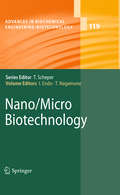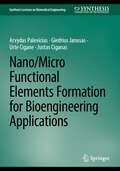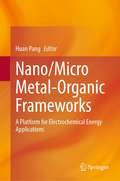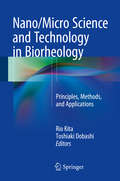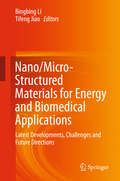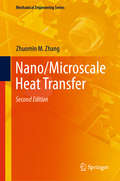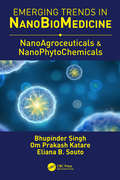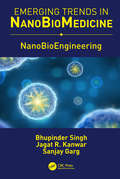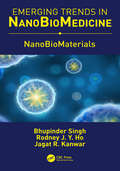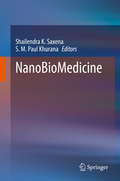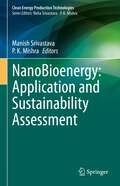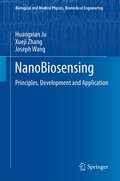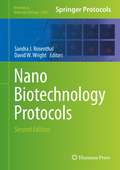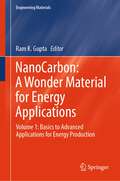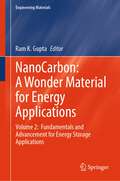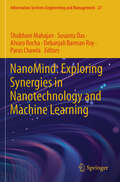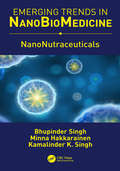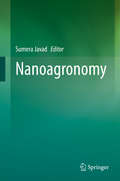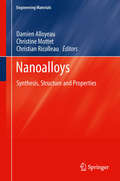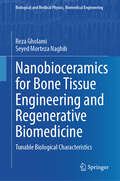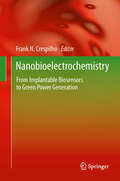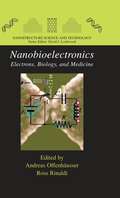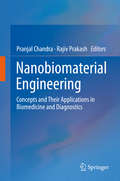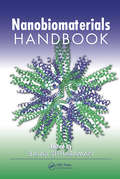- Table View
- List View
Nano/Micro Biotechnology
by Isao Endo Teruyuki NagamunePart I The Nano-Scale Biological Systems in Nature; Molecular bio-motors in living cells - by T. Nishizaka; The form designed by viral genome - by K. Onodera; Part II Detection and Characterization Technology; Atomic force microscopy applied to nano-mechanics of the cell - by A. Ikai; Design, synthesis and biological application of fluorescent sensor molecules for cellular imaging - by K. Kikuchi; Dynamic visualization of cellular signaling - by Q. Ni and J. Zhang; Part III Fabrication Technology; Surface acoustic wave atomizer and electrostatic deposition - by Y. Yamagata; Electrospray deposition of biomolecules by V.N. Morozov; Part IV Processing Technology; Droplet handling - by T.Torii; Integrated microfluidic systems - by S. Kaneda and T. Fujii; Part V Applications; A novel non-viral gene delivery system: Multifunctional envelope-type nano device - by H. Hatakeyama, H. Akita, K. Kogure, and H. Harashima; Biosensors - by M. Saito, H.M. Hiep, N. Nagatani, and E.Tamiya; Micro bioreactors - by Sato and T. Kitamori
Nano/Micro Functional Elements Formation for Bioengineering Applications (Synthesis Lectures on Biomedical Engineering)
by Giedrius Janusas Arvydas Palevicius Urte Cigane Justas CiganasIn recent years, various technologies dedicated to the formation of micro- and nanostructures have been intensively developed. Microstructures and nanostructures are manufactured from various materials with different parameters in a wide range of industrial sectors. These structures are used in devices such as biosensors, optical devices, microfluidic devices, electronic components, fluid mixing devices, particle separation or mixing devices, and single-molecule analysis devices. In this book technologies are being developed for the formation of nano/micro structures that allow the creation of new types of functional elements used in bioengineering. A magnetostrictive converter was developed and studied for the formation of microstructures in polymers, and a newly developed technology using mechanical vibrations during the chemical process was used to form aluminum nanopores. The synergy of these two technologies ensures the creation of a new type of functional elements used in bioengineering. It is presented how to replace the piezoelectric transducer with a magnetostrictive transducer in order to improve hot embossing technology for formation microstructures in polymers. The improved transducer would not only allow for the formation of structures at higher temperatures but would also eliminate the need for an additional heating element which generates a significant amount of heat during the process, thus optimising the device. The important aspects of this system include determining the working parameters of the structure formation which affect the quality and reproducibility of the structures. Research related to nanostructured nanoporous membranes has been receiving a lot of attention from scientists and businesspeople, which is why it is important to develop technologies and deepen knowledge about the chemical and physical processes that take place during fabrication to solve the challenges related to nanostructured membranes. Having it in mind this book presents a novel fabrication technology of nanoporous AAO membranes using vibrations, including production processes, their parameters, and a description of the properties of the fabricated membranes. Moreover, the book presents a technology for replicating the geometry of the AAO membrane in a biocompatible chitosan membrane, when nanopillars are formed on the surface of the chitosan membrane. It also presents the relationships and interactions studied between various parameters, which is achieved by presenting sets of experimental results. Combining these technologies the manufacturing of functional elements and their application to bioengineering. The book will be useful for researchers not only in Mechanical Engineering but also for Material Science and Chemical Engineering. It could be used for master and Ph.D. students too.
Nano/Micro Metal-Organic Frameworks: A Platform for Electrochemical Energy Applications
by Huan PangThis book systematically describes the design and synthesis of MOF-related materials and the electrochemical energy storage-related research in the field of batteries. It starts with an introduction to the synthesis of MOF-based materials and various MOF derivatives, such as MOF-derived porous carbon and MOF-derived metal nanoparticles. This is followed by highlighting the interesting examples for electrochemical applications, illustrating recent advances in battery, supercapacitor, and water splitting. This book is interesting and useful to a wide readership in the various fields of chemical science, materials science, and engineering.
Nano/Micro Science and Technology in Biorheology
by Rio Kita Toshiaki DobashiIntegrating basic to applied science and technology in medicine, pharmaceutics, molecular biology, biomedical engineering, biophysics and irreversible thermodynamics, this book covers cutting-edge research of the structure and function of biomaterials at a molecular level. In addition, it examines for the first time studies performed at the nano- and micro scale. With innovative technologies and methodologies aiming to clarify the molecular mechanism and macroscopic relationship, Nano/Micro Science and Technology in Biorheology thoroughly covers the basic principles of these studies, with helpful step-by-step explanations of methodologies and insight into medical applications. Written by pioneering researchers, the book is a valuable resource for academics and industry scientists, as well as graduate students, working or studying in bio-related fields.
Nano/Micro-Structured Materials for Energy and Biomedical Applications
by Bingbing Li Tifeng JiaoThis book discusses the latest developments of the synthesis, preparation, characterization, and applications of nano/microstructure-based materials in biomedical and energetic fields. It introduces several popular approaches to fabricating these materials, including template-assisted fabrication, electrospinning of organic/inorganic hybrid materials, biomineralization-mediated self-assembly, etc. The latest results in material evaluation for targeted applications are also presented. In particular, the book highlights the latest advances and future challenges in polymer nanodielectrics for energy storage applications. As such, it offers a valuable reference guide for scholars interested in the synthesis and evaluation of nano/microstructure-based materials, as well as their biomedical and energetic applications. It also provides essential insights for graduate students and scientists pursuing research in the broad fields of composite materials, polymers, organic/inorganic hybrid materials, nano-assembly, etc.
Nano/Microscale Heat Transfer (Mechanical Engineering Series)
by Zhuomin M. ZhangThis substantially updated and augmented second edition adds over 200 pages of text covering and an array of newer developments in nanoscale thermal transport. In Nano/Microscale Heat Transfer, 2nd edition, Dr. Zhang expands his classroom-proven text to incorporate thermal conductivity spectroscopy, time-domain and frequency-domain thermoreflectance techniques, quantum size effect on specific heat, coherent phonon, minimum thermal conductivity, interface thermal conductance, thermal interface materials, 2D sheet materials and their unique thermal properties, soft materials, first-principles simulation, hyperbolic metamaterials, magnetic polaritons, and new near-field radiation experiments and numerical simulations. Informed by over 12 years use, the author’s research experience, and feedback from teaching faculty, the book has been reorganized in many sections and enriched with more examples and homework problems. Solutions for selected problems are also available to qualified faculty via a password-protected website.• Substantially updates and augments the widely adopted original edition, adding over 200 pages and many new illustrations;• Incorporates student and faculty feedback from a decade of classroom use;• Elucidates concepts explained with many examples and illustrations;• Supports student application of theory with 300 homework problems;• Maximizes reader understanding of micro/nanoscale thermophysical properties and processes and how to apply them to thermal science and engineering;• Features MATLAB codes for working with size and temperature effects on thermal conductivity, specific heat of nanostructures, thin-film optics, RCWA, and near-field radiation.
NanoAgroceuticals & NanoPhytoChemicals
by Bhupinder SinghThis book volume encompasses the recent trends made in the applications of nanoscale tools for diverse constituents of plants and agriculture, particularly in addressing the critical issues related to their safety, efficacy, and efficient and cost-efficient development and production.
NanoBioEngineering
by Bhupinder Singh, Jagat R. Kanwar and Sanjay GargThe objective of this book is to provide the fundamental comprehension of a broad range of topics in an integrated volume such that readership hailing from diverse disciplines can rapidly acquire the necessary background for applying it in pertinent research and development field.
NanoBioMaterials
by Bhupinder Singh Rodney J. Y. Ho Jagat R. KanwarThe present book volume presents a holistic view of the aspects of nanobiomaterials incl. their stellar merits and limitations, applications in diverse fields, their futuristic promise in the fields of biomedical science and drug delivery. The federal & regulatory issues on the usage of nanobiomaterials have been assigned due consideration.
NanoBioMedicine
by Shailendra K. Saxena S. M. Paul KhuranaThis book provides a comprehensive overview of the recent trends in various Nanotechnology-based therapeutics and challenges associated with its development. Nanobiotechnology is an interdisciplinary research that has wide applications in the various fields of biomedical research. The book discusses the various facets of the application of Nanotechnology in drug delivery, clinical diagnostics, Nanomedicine and treatment of infectious and chronic diseases. The book also highlights the recent advancements on important devices and applications that are based on Nanotechnology in medicine and brief the regulatory and ethical issues related to nanomedical devices. It also reviews the toxicological profile of various nanomaterials and emphasizes the need for safe nanomaterials for clinical use. Finally, the book discusses the recent developments of potential commercial applications of Nanotechnology.
NanoBioenergy: Application and Sustainability Assessment (Clean Energy Production Technologies)
by P. K. Mishra Manish SrivastavaThis contributed volume presents new insight into sustainable possibilities of combination of nanomaterial and bioenergy production together. Biofuels as renewable energy sources have tremendous potential to replace fossil fuels in future energy scenario as biofuels production is likely to be advanced and novel research areas offers green alternative energy sources. continuous efforts are being made for the cost-effective production of biofuels worldwide to balance its techno-economy. In series of tremendous effort to improve biofuels production technologies, use of nanomaterials to improve biofuels production efficiency is highly emerging area with full scope to developed low cost, rapid technologies for biofuels production. The book covers the practical utility based properties of nanomaterial and bioenergy production together. It also discusses the recent advancements on various nanomaterial utility in biofuel production process along with its low cost application. It covers mega audiences, which include academician, researchers, and industries people. This book will be highly interesting for researchers and scientists as well as related industries.
NanoBiosensing
by Joseph Wang Huangxian Ju Xueji ZhangThis book will cover the full scope of nanobiosensing, which combines the newest research results in the cross-disciplines of chemistry, biology, and materials science with biosensing and bioanalysis to develop novel detection principles, sensing mechanisms, and device engineering methods. It not only covers the important types of nanomaterials for biosensing applications, including carbon nanotubes, carbon nanofiber, quantum dots, fullerenes, fluorescent and biological molecules, etc., but also illustrates a wide range of sensing principles, including electrochemical detection, fluorescence, chemiluminesence, antibody-antigen interactions, and magnetic detection. The book details novel developments in the methodology and devices of biosensing and bioanalysis combined with nanoscience and nanotechnology, as well as their applications in biomedicine and environmental monitoring. Furthermore, the reported works on the application and biofunction of nanoparticles have attracted extensive attention and interest, thus they are of particular interest to readers. The reader will obtain a rich survey of nanobiosensing technology, including the principles and application of biosensing, the design and biofunctionalization of bionanomaterials, as well as the methodology to develop biosensing devices and bioanalytical systems.
NanoBiotechnology Protocols
by Sandra J Rosenthal David W WrightHands-on experts in nanomaterial synthesis and application describe in detail the key experimental techniques currently employed in novel materials synthesis, dynamic cellular imaging, and biological assays. The author's emphasize diverse strategies to synthesize and functionalize the use of nanoparticles for biological applications. Additional chapters focus on the use of biological components (peptides, antibodies, and DNA) to synthesize and organize nanoparticles to be used a building block in larger assemblies. These new materials make it possible to image cellular processes for longer durations, leading to high throughput cellular-based screens for drug discovery, drug delivery, and diagnostic applications. Highlights include overview chapters on quantum dots and DNA nanotechnology, and cutting-edge techniques in the emerging nanobiotachnology arena.
NanoCarbon: Volume 1: Basics to Advanced Applications for Energy Production (Engineering Materials)
by Ram K. GuptaThis book is part of a 2 volume book series that provides current, state-of-the-art knowledge, fundamentals of electrochemistry, design strategies, and future challenges in carbon-based materials for electrochemical energy production and storage devices. The key goals for nanocarbons based electrochemical devices are to provide safe operation, sustainability, high energy and power density, long working life, and reduced cost. This book describes the fundamentals and working principles of nanocarbons for basic to advanced applications for energy storage devices such as photovoltaics, electrocatalyst, and fuel cells. The book is written by leading experts in these areas making this a suitable textbook for students and providing new directions to researchers and scientists working in science and technology areas.
NanoCarbon: Volume 2: Fundamentals and Advancement for Energy Storage Applications (Engineering Materials)
by Ram K. GuptaThis book is part of a 2 volume book series that provides current, state-of-the-art knowledge, fundamentals of electrochemistry, design strategies, and future challenges in carbon-based materials for electrochemical energy production and storage devices. The key goals for nanocarbons based electrochemical devices are to provide safe operation, sustainability, high energy and power density, long working life, and reduced cost. This book describes the fundamentals and working principles of nanocarbons for basic to advanced applications for energy storage devices such as metal-ion batteries, supercapacitors, and flexible energy storage devices. The book is written by leading experts in these areas making this a suitable textbook for students and providing new directions to researchers and scientists working in science and technology areas.
NanoCellBiology of Secretion
by Bhanu P. JenaUnderstanding live cells at the single molecule level is the most important and single major challenge facing biology and medicine today. Over the past 15 years, there has been a renewed understanding of living cells at the molecular level. Atomic Force Microscopy, Laser Force Microscopy, single secretory vesicle patch clamp studies, highresolution electron microscopy, and x-ray diffraction, are some of the tools now being used to unravel the intricacies of a living cell at the molecular level. Opening with an explanation of Materials and Methods, NanoCellBiology then moves through discussions of porosome discovery, calcium and SNARE-induced fusion, and vesicle swelling before winding up in a final chapter of conclusions and future studies. Succinctly packaged as SpringerBrief, this book is a must for those studying or conducting research in cell biology, biochemistry or nanobiology/nanotechnology. This book will be invaluable to faculty & graduate students involved in Nano Courses; Cell Biology Courses; Biophysics Courses; and Biochemistry Courses as well as practicing Cell Biologists, Biochemists and BioPhysicists.
NanoMind: Exploring Synergies in Nanotechnology and Machine Learning (Information Systems Engineering and Management #27)
by Alvaro Rocha Shubham Mahajan Paras Chawla Susanta Das Debanjali Barman RoyNanoMind" serves as a captivating exploration at the crossroads of nanotechnology and machine learning, revealing the profound synergies between these two groundbreaking fields. At its core, the book is a guided tour through the intricate realms of nanoscale materials and artificial intelligence, illuminating their combined potential to reshape the landscape of innovation. The journey begins with an introductory chapter, setting the stage for the convergence of nanotechnology and machine learning. Readers are introduced to the fundamental principles and applications of nanoscale materials, laying the groundwork for a deeper understanding of the nano-world. Simultaneously, the basics of machine learning are demystified, providing a comprehensive overview of the methodologies and concepts that underpin AI. "Nanoscale Sensing and Imaging" takes readers into the realm of advanced technologies, showcasing how machine learning enhances our ability to sense and image materials at the nanoscale. The narrative then seamlessly transitions to the creation and optimization of materials with nano-enhancements in "Nano-Enabled Materials." This section demonstrates how the marriage of nanotechnology and machine learning can lead to the development of materials with unprecedented properties, fostering innovation in diverse industries. The exploration extends into the field of healthcare with "Machine Learning in Nanomedicine," unveiling how AI at the nanoscale is transforming diagnostics, drug delivery, and personalized medicine. "Quantum Computing and Nanotechnology" delves into the cutting-edge intersection of quantum computing, nanotech, and machine learning, showcasing the potential for revolutionary advancements in computation and problem-solving. However, the journey isn't without its challenges. The book devotes a section to "Challenges and Ethical Considerations," addressing the complexities and ethical dimensions associated with the convergence of nanotechnology and machine learning. This discussion ensures that readers are equipped to navigate the ethical landscape responsibly.
NanoNutraceuticals
by Bhupinder SinghThis book will be a comprehensive account of the various facets of nutraceuticals domain. The peruser of this book will find details on various nanotech approaches to nutraceuticals, prebiotics and probiotics, along with their specific applications.
Nanoagronomy
by Sumera JavadIn this age of population explosion and depleting natural resources, this book offers new techniques to produce more from agricultural crops at a lower cost. The field of agronomy addresses this issue and interacts with the fields of agriculture, botany, and economics. Nanotechnology and nanoparticles play a role in agronomy. This book will join the techniques from both fields to construct one comprehensive book. Students of agriculture, physics, nanotechnology, and plant sciences will benefit equally from this work.
Nanoalloys
by Christine Mottet Christian Ricolleau Damien AlloyeauBimetallic nanoparticles, also called nanoalloys, are at the heart of nanoscience because of their ability to tune together composition and size for specific purposes. By approaching both their physical and chemical properties, Nanoalloys: Synthesis, Structure & Properties provides a comprehensive reference to this research field in nanoscience by addressing the subject from both experimental and theoretical points of view, providing chapters across three main topics: Growth and structural properties Thermodynamics and electronic structure of nanoalloys Magnetic, optic and catalytic properties The growth and elaboration processes which are the necessary and crucial part of any experimental approach are detailed in the first chapter. Three chapters are focused on the widely used characterization techniques sensitive to both the structural arrangements and chemistry of nanoalloys. The electronic structure of nanoalloys is described as a guide of useful concepts and theoretical tools. Chapters covering thermodynamics begin with bulk alloys, going to nanoalloys via surfaces in order to describe chemical order/disorder, segregation and phase transitions in reduced dimension. Finally, the optical, magnetic and catalytic properties are discussed by focusing on nanoparticles formed with one element to track the modifications which occur when forming nanoalloys. The range and detail of Nanoalloys: Synthesis, Structure & Properties makes it an ideal resource for postgraduates and researchers working in the field of nanoscience looking to expand and support their knowledge of nanoalloys.
Nanobioceramics for Bone Tissue Engineering and Regenerative Biomedicine: Tunable Biological Characteristics (Biological and Medical Physics, Biomedical Engineering)
by Reza Gholami Seyed Morteza NaghibThis book presents the tunable biological characteristics of nanobioceramics and focuses on some challenges in bone tissue engineering and regenerative medicine. Synthetic composite-based materials and scaffolds should be biodegradable, biocompatible and supply sufficient structural aid for cell migration, along with oxygen, waste, and nutrient carriage to accelerate bone regeneration process and remodeling in defects. These properties may be reached by functioning tunable physical features, including absorption rate, degradation rate, modulus, porosity, and swelling by adjustments with the addition of ceramic phases and copolymers as synthetic composite scaffolds. Synthetic bioceramics seek to imitate the natural hydroxyapatite (HA) crystal creation located in bone. These ceramics, particularly calcium phosphates, have exhibited great osteoinductivity, osteoconductivity, and biocompatibility. Lately, silicon-based glass-ceramics have been investigated as a substitution of calcium phosphates. Several members of this collection exhibit high bioactivity, have attractive mechanical strength, and are known to increase cell proliferation, adhesion, and mineralization of extracellular matrix. Moreover, antibacterial properties of some nanostructured bioceramics established significant interests in avoiding implants rejection in surgery and biomedicine.
Nanobioelectrochemistry
by Frank N. CrespilhoNanobioelectrochemistry covers the modern aspects of bioelectrochemistry, nanoscience and materials science. The combination of nanostructured materials and biological molecules enables the development of biodevices capable to detect specific substances. Furthermore, by using the bioelectrochemistry approach, the interaction between bio-systems and nanostructured materials can be studied at the molecular level, where several mechanisms of molecular behavior are elucidate from redox reactions. The combination of biological molecules and novel nanomaterials components is of great importance in the process of developing new nanoscale devices for future biological, medical and electronic applications. This book describes some of the different electrochemical techniques that can be used to study new strategies for patterning electrode surfaces with enzymes, organelles, cells and biomimetic systems. Also, it focuses on how enzymes and microorganisms can be used as biological catalysts in fuel cells for green power generation. By bringing together these different aspects of nanobioelectrochemistry, this book provides a valuable source of information for many students and scientists.
Nanobioelectronics - for Electronics, Biology, and Medicine
by Ross Rinaldi Andreas OffenhäusserThe range of themes addressed in this book emphasize key aspects and the future perspectives of nano-bioelectronics. The book discusses the electronic coupling of DNA and proteins with electronic devices to build new information systems and to apply the systems as biosensors. The exploitation of networks of neurons connected with electronic devices in future information processing systems and the use of nano-objects to assess cellular function is also discussed in detail. The topics of these hybrid nano-bioelectronic systems are both interesting for fundamental research and to enhance industrial competitiveness through research, education, and transfer of technology.
Nanobiomaterial Engineering: Concepts and Their Applications in Biomedicine and Diagnostics
by Pranjal Chandra Rajiv PrakashThis book comprehensively documents the application of Nanobiomaterials in the field of bio-medicine and diagnostics technologies by involving classical concepts/examples. Nanobiotechnology is an emerging area which encompasses all the facets of research of nano and biomaterials with their interaction with biological systems. The book briefly summarizes the various types of Nanomaterial’s, and highlights the recent developments in the synthesis of the nanomaterials for the diagnostic and therapeutic biomedical applications. It skilfully reviews the utilization of the nanomaterials alone or in combination with other bio-molecules as a contrast enhancer in in-vivo imaging, Nano-Theranostics, drug delivery, and sensing transducer matrix. It also discusses the current research on designing of the new Nanobiomaterials and their implementation in numerous fields including bio-medicine and diagnostics. Finally, it summarizes the future prospects and the commercial viability of Nanobiomaterials in the human health care.
Nanobiomaterials Handbook
by Balaji SitharamanNanobiomaterials exhibit distinctive characteristics, including mechanical, electrical, and optical properties, which make them suitable for a variety of biological applications. Because of their versatility, they are poised to play a central role in nanobiotechnology and make significant contributions to biomedical research and healthcare. Nanobio
